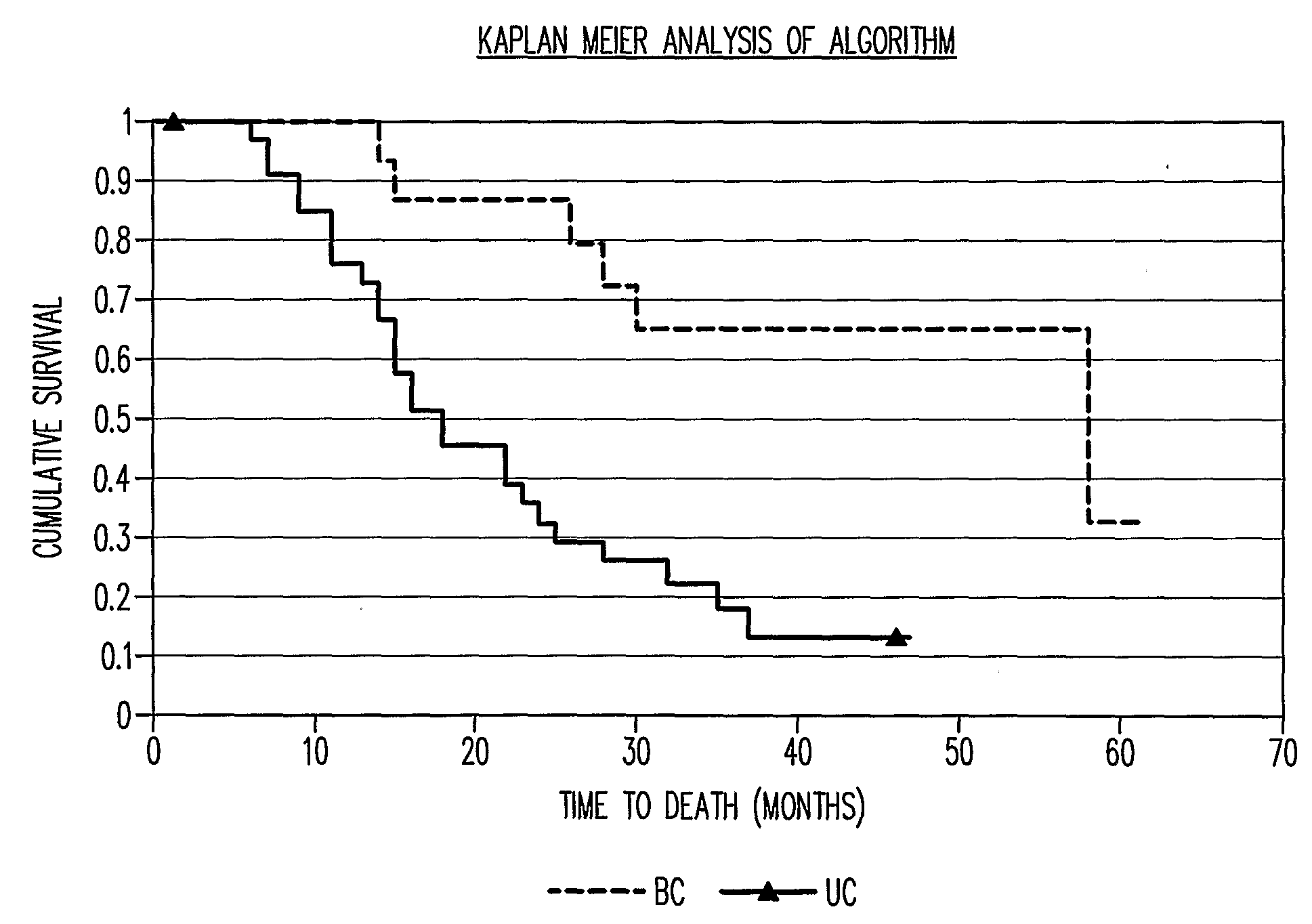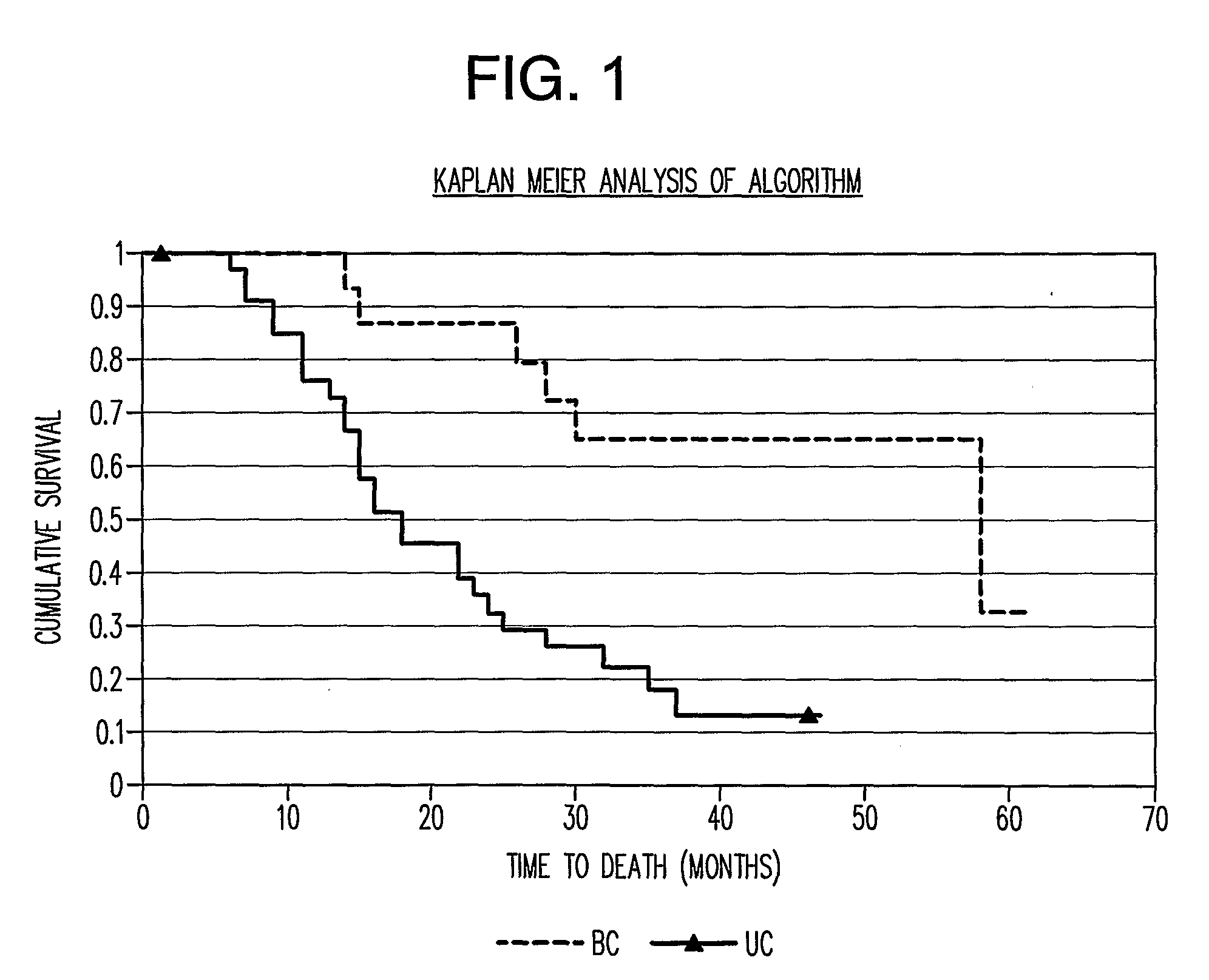Neoplastic Disease-Related Methods, Kits, Systems and Databases
a technology of neoplastic disease and kits, applied in the field of neoplastic disease related methods, kits, systems and databases, can solve the problems of less effective strategies to prevent distant recurrence in rectal cancer, limited diagnostic accuracy of these approaches, and surgical interventions that are often more radical than others, so as to increase and reduce the chance of patient survival
- Summary
- Abstract
- Description
- Claims
- Application Information
AI Technical Summary
Benefits of technology
Problems solved by technology
Method used
Image
Examples
example 1
Colorectal Cancer Patient Treatment
Summary
[0215]A statistically significant discrimination of patient overall survival (p less than about 0.05 level when calculated with Kaplan-Meier plots) was achieved (even in single parameter analysis) using methods of the invention. Elevated or decreased levels of serum markers were compared with normal control levels or adjusted mean levels of diseased cohorts. The significance of individual markers was determined by calculating the Kaplan-Meier plots from patients (using the upper or lower quartile of the individual marker levels). A decrease or increase in the levels of the markers in the cancer patient compared to the levels in normal controls indicated an increase in stage, grade, severity, advancement or progression of the patient's cancer and / or a lack of efficacy or benefit of the cancer treatment or therapy. In particular, high levels of Gastrin, CA 19-9, TIMP-1, and low level of EGFr, MMP-2 correlated with poor prognosis. In addition c...
example 2
Determination of Predictor Values and Derivation of Related Algorithm
Summary
[0219]Serum samples obtained from each patient as described in Example 1 were analyzed and neoplastic disease marker level values were used to generate algorithmically predictor values which correlated with patient survival.
Data Transformations
[0220]Values for the following seventeen markers were reported prior to the start of chemotherapy and during each of the chemotherapy cycles described below: MMP2, TIMP1, MMP9, Collagen IV, Collagen VI, PIIINP, Tenascin, Laminin, CEA, CA19-9, sHer-2 / neu, EGFR, uPA, PAI-1, Gastrin, IL2R, and IL6.
[0221]Tables 4A and 4B display experimental data as determined by duplicate or triplicate measurements for each of the 17 indicated markers in the pretreatment serum sample.
TABLE 4AExperimental Data and Threshold determinationCO1037,6CO 674CO 316CO 33,7CutOff 1083CutOff 9,17CutOff 7,2CutOff 15 ngPatient IDSurvivalSurvivalTIMP-1MMP-2COLIVLamininTenascinPIIINPCol VIHer2 / neuIDstatu...
example 3
Expression Analysis of Primary and Metastatic Tumor Tissue by Analysis of Paraffin-Embedded Tumor Tissue
Summary
[0243]Paraffin embedded, Formalin-fixed tissues of surgical resectates of patient as described in Example 1 were analyzed and neoplastic disease marker level values were determined by qRT-PCR techniques and correlated with patient survival.
Expression Profiling Utilizing Quantitative Kinetic RT-PCR
[0244]RNA was isolated from paraffin-embedded, formalin-fixed tissues (=FFPE tissues). Those skilled in the art are able to perform RNA extraction procedures. For example, total RNA from a 5 to 10 μm curl of FFPE tumor tissue can be extracted using the High Pure RNA Paraffin Kit (Roche, Basel, Switzerland), quantified by the Ribogreen RNA Quantitation Assay (Molecular Probes, Eugene, Oreg.) and qualified by real-time fluorescence RT-PCR of a fragment of RPL37A. In general 0.5 to 2 ng RNA of each qualified RNA extraction was assayed by qRT-PCR as described below. For a detailed anal...
PUM
| Property | Measurement | Unit |
|---|---|---|
| Volume | aaaaa | aaaaa |
| Volume | aaaaa | aaaaa |
| Mass | aaaaa | aaaaa |
Abstract
Description
Claims
Application Information
 Login to View More
Login to View More - R&D
- Intellectual Property
- Life Sciences
- Materials
- Tech Scout
- Unparalleled Data Quality
- Higher Quality Content
- 60% Fewer Hallucinations
Browse by: Latest US Patents, China's latest patents, Technical Efficacy Thesaurus, Application Domain, Technology Topic, Popular Technical Reports.
© 2025 PatSnap. All rights reserved.Legal|Privacy policy|Modern Slavery Act Transparency Statement|Sitemap|About US| Contact US: help@patsnap.com



